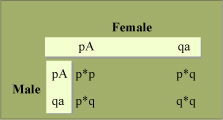This section provides outlines and questions for a few of the lecture sessions. Additional lecture notes are forthcoming.
| LEC # | TOPICS |
|---|---|
| 1 | Introduction: The Basic Dynamical Systems of Evolution (PDF) |
| 6 | Evolution at the Molecular Level I (PDF) |
| 19 | Host-parasite Interactions and Disease Models (PDF) |
Questions
Before and after every lecture, questions for further discussion and reflection were provided. Questions for lecture 1 and lecture 2 are given below:
Lec #1: Introduction - Rice: Chapter 1
- Why do organisms require evolutionary theory? What is it about organisms that requires an evolutionary accounting?
- Do all historical processes require a selectionist account?
- What are the major features of organic diversity?
- What other classes of objects, besides organisms, are conditioned by history?
- Describe the organization of morphospace. How is it clustered?
- How is individuality (variation within each type) like/unlike that found in minerals?
- What about the distribution of forms in morphospace encourages an historical explanation?
- Does perfection of organic design require evolutionary explanation?
- What is the principle of historical inference?
- How are the “quirks” within adaptations “signs of the past”?
- Distinguish transformational and variational evolution.
- How are changes in an ensemble different in biological evolution than in stellar evolution?
- Why is sieving useless without heritability of traits?
Additional Readings:
Gould, S. J. The Panda’s Thumb: More Reflections in Natural History. Reissue ed. New York, NY: W.W. Norton and Company, 1992. ISBN: 9780393308198 .
Lec #2: Population Genetics - Rice: Chapter 1 and 2
- Describe the way variation, heritability and differential reproduction convert individual variation to population variation.
- Why does every population have differential reproduction? Does this always imply natural selection?
- How do we find out if variation is heritable? Why is this especially difficult with animal behavior?
- Are chromosome number and shape invariant in a population? (Discuss supernumerary chromosomes, inversion loops,…)
- How much protein variation is there for sexually reproducing species? What are poly-morphic loci?
- How big does a population have to be to realize Hardy Weinberg assumptions?
- Contrast continuous and discrete population growth models.
- Compare fitness as defined in terms of contribution to the succeeding generation and fitness in terms of optimality.
- What are Mendel’s laws? In what way are they laws?
- Is simple dominance common? Do all loci assort independently?
- Describe segregation distortion. How is the t-allele retained by the population?
- Define endogamy, planktonic mating, gene frequency (allele frequency), and gamete distribution.
- How do we move from phenotypic to genotypic frequency.
- Derive the Hardy-Weinberg equilibrium. What assumptions must be made?
- What does the following table illustrate? Focus on the assumptions that have to be made to apply this model.
 Allele frequencies.
Allele frequencies.
- What happens to the allele frequency after one round of random mating? How does this show that heritable variation is conserved?
- Can simple blending be simulated by having a trait that is the result of many loci? How does this difference reinvigorate Darwin’s whole argument? (This is a critical point, make sure you can answer this.)
- Discuss the relationship between environment, genetics and development.
- In what ways is DNA ‘self-reproducing’?
- Discuss the following: * Differential reproduction is not equivalent to natural selection. * Natural selection operating at various levels (e.g. group and kin selection with respect to altruism). * How does vegetative growth make the evaluation of fitness by “counting heads” difficult? * What are some causes of differential reproduction? * Discuss the fitness of phenotypic classes and the fitness of genotypic classes.
- Define allele, genotype, fitness, relative fitness, absolute fitness, mean population fitness, marginal fitness, viability selection, sexual selection, fertility selection, adaptive landscape, Darwinian extinction, mutation-selection equilibrium, mutational load, segregation load, outcrossing, additive genetic variance, fundamental theorem of natural selection, norms of reaction.
Additional Readings:
Binomial distribution can be found in any introductory statistics book, e.g.
Kachigan, S. K. Statistical Analysis_._ New York, NY: Radius Press, 1991, pp. 122-126. ISBN: 9780942154917 .
 Dupré, John, ed. The Latest on the Best: Essays on Evolution and Optimality. Cambridge, MA: MIT Press, August 1987. ISBN: 9780262040907 .
Dupré, John, ed. The Latest on the Best: Essays on Evolution and Optimality. Cambridge, MA: MIT Press, August 1987. ISBN: 9780262040907 .










